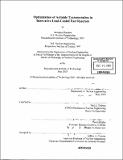Optimization of actinide transmutation in innovative lead-cooled fast reactors
Author(s)
Romano, Antonino, 1972-
DownloadFull printable version (14.03Mb)
Other Contributors
Massachusetts Institute of Technology. Dept. of Nuclear Engineering.
Advisor
Neil E. Todreas.
Terms of use
Metadata
Show full item recordAbstract
The thesis investigates the potential of fertile free fast lead-cooled modular reactors as efficient incinerators of plutonium and minor actinides (MAs) for application to dedicated fuel cycles for transmutation. A methodology is developed that assesses the actinide incineration performance of several transmutation fuel cycles, both single and multi-tiered, on the basis of performance indicators related to the reduction of actinide mass at the repository and economics. Application of the methodology indicates that fast fertile-free critical reactors that bum plutonium and MAs applied to both one-tier and two-tier fuel cycles with fuel reprocessing have the potential to be more economical than other dedicated systems like the ATW. Hence the thesis studies two lead-cooled critical reactors that employ fertile-free fuel as possible candidates. The two designs proposed are: an actinide burner reactor (ABR), designed to incinerate mostly plutonium and some MAs from the spent fuel of the conventional LWR fleet, and a minor a ctinide buumer reactor (MABR), devoted to bum mostly minor actinides and some plutonium both recycled from the burner and produced by the LWR fleet that should be integrated in a two-tier fuel cycle where most of the plutonium is fed back to advanced thermal reactors or conventional fast reactors (first tier) for incineration. These designs incorporate several advanced technical solutions such as fuel assemblies with streaming elements, double-entry control rods and special absorbing materials that establish favorable neutronics characteristics and excellent self-controllability features, comparable to those of the Integral Fast Reactor (IFR) core. (cont.) Specifically, the designs achieve (a) negative reactivity feedbacks based on coolant voiding, Doppler and fuel and core structure thermal expansion effects; (b) satisfactory values for the effective delayed neutron fractions, comparable to those reported for the IFR; (c) proliferation resistance with dilution of the plutonium vector, which is practically unusable for nuclear weapons fabrication. The safety features of these designs is assessed by applying a thermal-hydraulic code that simulates the worst accident scenarios envisaged for the burners. Application of the fuel cycle methodology to both designs shows that a) deployment of the MABR as the burner in the two-tier fuel cycle is the most efficient strategy to manage actinides and that b) both designs yield lower fuel cycle costs compared to the subcritical reactors.
Description
Thesis (Ph. D.)--Massachusetts Institute of Technology, Dept. of Nuclear Engineering, 2003. Includes bibliographical references (leaves 228-232).
Date issued
2003Department
Massachusetts Institute of Technology. Department of Nuclear Engineering; Massachusetts Institute of Technology. Department of Nuclear Science and EngineeringPublisher
Massachusetts Institute of Technology
Keywords
Nuclear Engineering.